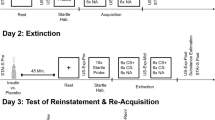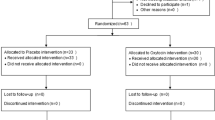Abstract
Rationale
Classical conditioning of a fear response involves the formation of an association between a stimulus and an emotional response and can be seen as a basic form of emotional memory. While both benzodiazepines and stimulant drugs may influence the formation of episodic memories for emotional events, their effects on fear conditioning are less clear.
Objectives
This study compared the effects of diazepam with methylphenidate on fear conditioning.
Materials and methods
In a single-session between groups design with three conditions [placebo, diazepam (10 mg), and methylphenidate (40 mg)], classical conditioning of a skin conductance response to a visual stimulus previously paired with a 100-db white noise was tested in 45 healthy volunteers.
Results
Diazepam blocked fear conditioning, despite responses to the unconditioned aversive stimulus and neutral control stimulus being unimpaired. Conditioning remained intact after methylphenidate. Conditioned responses were not extinguished completely by the end of the experiment, and it was not possible to draw conclusions about the effects of the drugs on extinction.
Conclusions
Although diazepam has well-documented amnesic effects, it has not been found to affect implicit forms of memory like perceptual and conceptual priming. As the present study found impaired fear conditioning after diazepam, it adds weight to recent findings that emotional memories are disproportionately impaired by the benzodiazepines.




Similar content being viewed by others
Notes
i.e., on a trial were a participant gave no response, their response was counted as −2 log10 μS; i.e., trials with no recordable response were included in this calculation, but not the calculation of amplitude. Data available on request.
Hamann et al. 2002 argue that because the response to the US is so much larger than the response to the CS+, the response to the CS+US combined can be used to accurately estimate response to the US.
The covariate was not used in this analysis as all the participants made responses to the CS+US combination in the continuous reinforcement phase.
References
Beaver JD, Mogg K, Bradley BP (2005) Emotional conditioning to masked stimuli and modulation of visuospatial attention. Emotion 5:67–79
Bechara A, Tranel D, Damasio H, Adolphs R, Rockland C, Damasio AR (1995) Double dissociation of conditioning and declarative knowledge relative to the amygdala and hippocampus in humans. Science 269(5227):1115–1118
Bishop KI, Curran HV (1998) An investigation of the effects of benzodiazepine receptor ligands and of scopolamine on conceptual priming. Psychopharmacologia 140(3):345–353
Bishop KI, Curran HV, Lader M (1996) Do scopolamine and lorazepam have dissociable effects on human memory systems? A dose–response study with normal volunteers. Exp Clin Psychopharmacol 4(3):292–299
Bond A, Lader M (1974) The use of analogue scales in rating subjective feelings. Br J Med Psychol 47(3):211–218
Buchanan TW, Karafin MS, Adolphs R (2003) Selective effects of triazolam on memory for emotional, relative to neutral, stimuli: differential effects on gist versus detail. Behav Neurosci 117(3):517–525
Buchel C, Dolan RJ (2000) Classical fear conditioning in functional neuroimaging. Curr Opin Neurobiol 10(2):219–223
Buchel C, Morris J, Dolan RJ, Friston KJ (1998) Brain systems mediating aversive conditioning: an event-related fMRI study. Neuron 20(5):947–957
Cahill L, McGaugh JL (1998) Mechanisms of emotional arousal and lasting declarative memory. Trends Neurosci 21(7):294–299
Cahill L, Haier RJ, White NS, Fallon J, Kilpatrick L, Lawrence C et al (2001) Sex-related difference in amygdala activity during emotionally influenced memory storage. Neurobiol Learn Mem 75(1):1–9
Clark RE, Squire LR (1998) Classical conditioning and brain systems: the role of awareness. Science 280:77–81
Clark CRG, Geffen GM, Geffen LB (1986) Role of monoamine pathways in the control of attention: effects of droperidol and methylphenidate in normal adult humans. Psychopharmacology (Berl) 90:28–34
Curran HV (2000) Psychopharmacological approaches to human memory. In: Gazzaniga MS (ed) The new cognitive neurosciences. MIT, Cambridge, MA, pp 797–804
Davis M (1979) Diazepam and flurazepam: effects on conditioned fear as measured with the potentiated startle paradigm. Psychopharmacology (Berl) 62(1):1–7
Dawson ME, Schell AM (1985) Information processing and human autonomic classical conditioning. In: Ackles PK, Jennings JR, Coles MGH (eds) Advances in psychophysiology. JAI, Greenwich, CT, pp 89–165
Elliott R, Sahakian BJ, Matthews K, Bannerjea A et al (1997) Effects of methylphenidate on spatial working memory and planning in healthy young adults. Psychopharmacology (Berl) 131:196–206
Esteves F, Parra C, Dimberg U, Ohman A (1994) Nonconscious associative learning: Pavlovian conditioning of skin conductance responses to masked fear-relevant facial stimuli. Psychophysiology 31:375–385
Fang JC, Hinrichs JV, Ghoneim MM (1987) Diazepam and memory: evidence for spared memory function. Pharmacol Biochem Behav 28(3):347–352
Fanselow MS, LeDoux JE (1999) Why we think plasticity underlying Pavlovian fear conditioning occurs in the basolateral amygdala. Neuron 23(2):229–232
Fendt M, Fanselow MS (1999) The neuroanatomical and neurochemical basis of conditioned fear. Neurosci Biobehav Rev 23(5):743–760
Gabrieli JD, McGlinchey-Berroth R, Carrillo MC, Gluck MA, Cermak LS, Disterhoft JF (1995) Intact delay-eyeblink classical conditioning in amnesia. Behav Neurosci 109:819–827
Geddes SM, Gray WM, Millar K, Asbury AJ (1993) Skin conductance responses to auditory stimuli and anticipatory responses before venepuncture in patients premedicated with diazepam or morphine. Br J Anaesth 71(4):512–516
Geddes SM, Gray WM, Asbury AJ (1994) Skin conductance responses in patients sedated with midazolam or propofol. Br J Anaesth 73(3):345–349
Gray JA, Young AM, Joseph MH (1997) Dopamine’s role. Science 278(5343):1548–1549
Grillon C, Baas JM (2002) Comments on the use of the startle reflex in psychopharmacological challenges: impact of baseline startle on measurement of fear-potentiated startle. Psychopharmacology (Berl) 164:236–238
Grillon C, Hill J (2003) Emotional arousal does not affect delay eyeblink conditioning. Brain Res Cogn Brain Res 17(2):400–405
Guscott MR, Cook GP, Bristow LJ (2000) Contextual fear conditioning and baseline startle responses in the rat fear-potentiated startle test: a comparison of benzodiazepine/gamma-aminobutyric acid-A receptor agonists. Behav Pharmacol 11(6):495–504
Hamann S, Monarch ES, Goldstein FC (2002) Impaired fear conditioning in Alzheimer’s disease. Neuropsychologia 40(8):1187–1195
Hardman JG, Limbird LE, Gilman AG (eds) (2001) Goodman & Gilman’s the pharmacological basis of therapeutics, 10th edn. McGraw-Hill, New York
Harris JA, Westbrook RF (2001) Contextual control over the expression of fear in rats conditioned under a benzodiazepine. Psychopharmacology (Berl) 156(1):92–97
Hellewell JS, Guimaraes FS, Wang M, Deakin JF (1999) Comparison of buspirone with diazepam and fluvoxamine on aversive classical conditioning in humans. J Psychopharmacol 13(2):122–127
Iacono WG, Boisvenu GA, Fleming JA (1984) Effects of diazepam and methylphenidate on the electrodermal detection of guilty knowledge. J Appl Psychol 69(2):289–299
Iacono WG, Cerri AM, Patrick CJ, Fleming JA (1992) Use of antianxiety drugs as countermeasures in the detection of guilty knowledge. J Appl Psychol 77(1):60–64
Jensen HH, Hutchings B, Poulsen JC (1989) Conditioned emotional responding under diazepam: a psychophysiological study of state dependent learning. Psychopharmacology (Berl) 98(3):392–397
Knight DC, Nguyen HT, Bandettini PA (2003) Expression of conditional fear with and without awareness. Proc Natl Acad Sci U S A 100:15280–15283
LaBar KS, LeDoux JE, Spencer DD, Phelps EA (1995) Impaired fear conditioning following unilateral temporal lobectomy in humans. J Neurosci 15(10):6846–6855
LeDoux J (1998) Fear and the brain: where have we been, and where are we going? Biol Psychiatry 44(12):1229–1238
LeDoux J (2000) Emotion circuits in the brain. Annu Rev Neurosci 23:155–184
Lobb H (1968) Trace GSR conditioning with benzedrine in mentally defective and normal adults. Am J Ment Defic 73(2):239–246
Lovibond PF, Shanks DR (2002) The role of awareness in Pavlovian conditioning: empirical evidence and theoretical implications. J Exp Psychol Anim Behav Processes 28:3–26
Maren S (2001) Neurobiology of Pavlovian fear conditioning. Annu Rev Neurosci 24:897–931
Marsicano G, Wotjak CT, Azad SC, Bisogno T, Rammes G, Cascio MG et al (2002) The endogenous cannabinoid system controls extinction of aversive memories. Nature 418(6897):530–534
Mehta MA, Owen AM, Sahakian BJ, Mavaddat N, Pickard JD, Robbins TW (2000) Methylphenidate enhances working memory by modulating discrete frontal and parietal lobe regions in the human brain. J Neurosci 20:RC65
Molander L (1982) Effect of melperone, chlorpromazine, haloperidol, and diazepam on experimental anxiety in normal subjects. Psychopharmacology (Berl) 77(2):109–113
Morris JS, Friston KJ, Dolan RJ (1997) Neural responses to salient visual stimuli. Proc R Soc Lond B Biol Sci 264(1382):769–775
Morris JS, Ohman A, Dolan RJ (1998) Conscious and unconscious emotional learning in the human amygdala. Nature 393:467–470
Neisser U, Harsch N (1992) Phantom flashbulbs: false recollections of hearing news about the Challenger. In: Winograd E, Neisser U (eds) Affect and accuracy in recall: studies of “Flashbulb” memories. Cambridge University Press, London, pp 9–31
Papka M, Ivry RB, Woodruff-Pak DS (1997) Eyeblink classical conditioning and awareness revisited. Psychol Sci 8:404–408
Perruchet P (1985) A pitfall for the expectancy theory of human eyelid conditioning. Pavlovian J Biol Sci 20:163–170
Pezze MA, Feldon J (2004) Mesolimbic dopaminergic pathways in fear conditioning. Prog Neurobiol 74(5):301–320
Phelps EA, LaBar KS, Anderson AK, O’Connor KJ, Fulbright RK, Spencer DD (1998) Specifying the contributions of the human amygdala to emotional memory: a case study. Neurocase 4(6):527–540
Prokasy WF, Williams WC, Kumpfer KL, Lee WY, Jenson WR (1973) Differential SCR conditioning with two control baselines: random signal and signal absent. Psychophysiology 10(2):145–153
Rogers RD, Blackshaw AJ, Middleton HC, Matthews K, Hawtin K, Crowley C, Hopwood A, Wallace C, Deakin J-FW, Sahakian BJ, Robbins TW (1999) Tryptophan depletion impairs stimulus–reward learning while methylphenidate disrupts attentional control in healthy young adults: implications for the monoaminergic basis of impulsive behaviour. Psychopharmacology (Berl) 146:482–491
Sanger DJ, Joly D (1985) Anxiolytic drugs and the acquisition of conditioned fear in mice. Psychopharmacology (Berl) 85(3):284–288
Scaife JC, Langley RW, Bradshaw CM, Szabadi E (2005) Diazepam suppresses the acquisition but not the expression of ‘fearpotentiation’ of the acoustic startle response in man. J Psychopharmacol 19:347–356
Schell AM, Dawson ME, Marinkovic K (1991) Effects of potentially phobic conditioned stimuli on retention, reconditioning, and extinction of the conditioned skin conductance response. Psychophysiology 28:140–153
Shanks D, Channon S, Wilkinson L, Curran HV (2005) Disruption of sequential priming in organic and pharmacological amnesia: a role for the medial temporal lobes in implicit contextual learning. Neuropsychopharmacology (in press). DOI 10.1038/sj.npp.1300935
Sharot T, Delgado MR, Phelps EA (2004) How emotion enhances the feeling of remembering. Nat Neurosci 7:1376–1380
Skinner BF (1938) The behavior of organisms: an experimental analysis. Prentice-Hall, Englewood Cliffs, NJ
Smith CN, Clark RE, Manns JR, Squire LR (2005) Acquisition of differential delay eyeblink classical conditioning is independent of awareness. Behav Neurosci 119:78–86
Soares JJ, Ohman A (1993) Backward masking and skin conductance responses after conditioning to nonfeared but fear-relevant stimuli in fearful subjects. Psychophysiology 30:460–466
Squire LR (1992) Memory and the hippocampus: a synthesis from findings with rats, monkeys, and humans. Psychol Rev 99:195–231
Talarico JM, Rubin DC (2003) Confidence, not consistency, characterizes flashbulb memories. Psychol Sci 14:455–461
Vazdarjanova A (2000) Does the basolateral amygdala store memories for emotional events? Trends Neurosci 23(8):345–346
Venables PH, Christie MJ (1980) Electrodermal activity. In: Martin I, Venables PH (eds) Techniques in psychophysiology. Wiley, New York, pp 3–67
Vidailhet P, Kazes M, Danion JM, Kauffmann-Muller F, Grange D (1996) Effects of lorazepam and diazepam on conscious and automatic memory processes. Psychopharmacology (Berl) 127(1):63–72
Westbrook RF, Greeley JD, Nabke CP, Swinbourne AL (1991) Aversive conditioning in the rat: effects of a benzodiazepine and of an opioid agonist and antagonist on conditioned hypoalgesia and fear. J Exp Psychol Anim Behav Processes 17(3):219–230
Zangara A, Curran HV (2000) Tranquilising emotional memories: acute effects of metaprolol, diazepam, and placebo in healthy volunteers. J Psychopharmacol 14S(3):A43
Zangara A, Blair RJR, Curran HV (2002) A comparison of the effects of a beta-adrenergic blocker and a benzodiazepine upon the recognition of human facial expressions. Psychopharmacologia 163:36–41
Author information
Authors and Affiliations
Corresponding author
Rights and permissions
About this article
Cite this article
Brignell, C.M., Curran, H.V. Drugs, sweat, and fears: a comparison of the effects of diazepam and methylphenidate on fear conditioning. Psychopharmacology 186, 504–516 (2006). https://doi.org/10.1007/s00213-006-0363-x
Received:
Accepted:
Published:
Issue Date:
DOI: https://doi.org/10.1007/s00213-006-0363-x




